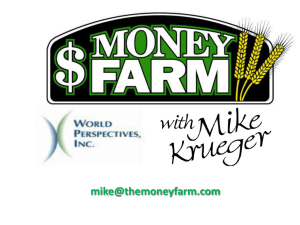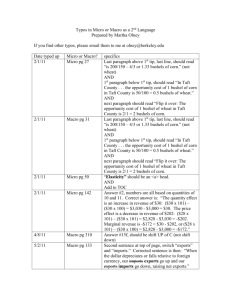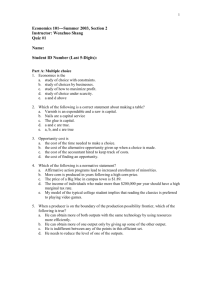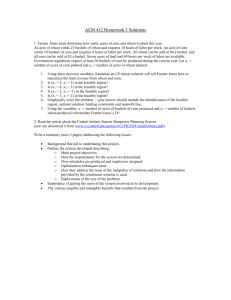Calculating Opportunity Costs Input Problem
advertisement
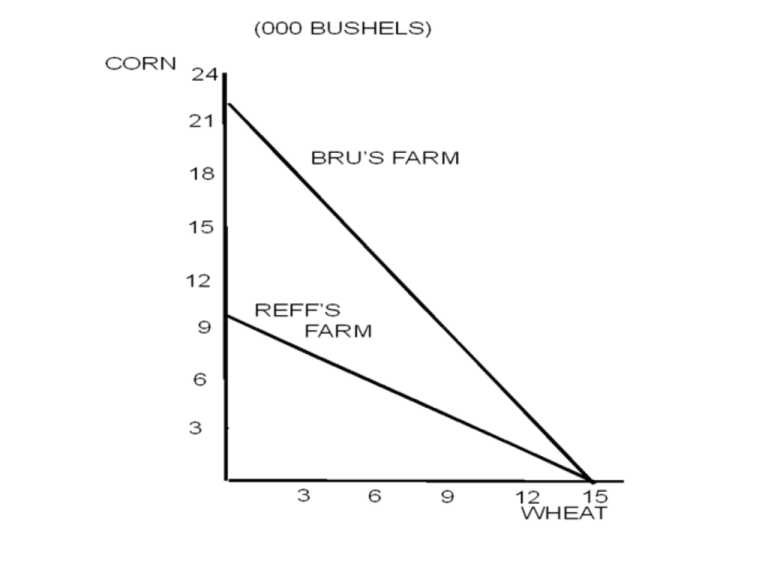
Chapter 4 Reading Homework: Read Chapter 4 and answer the following: 1. What are the ten important characteristics of the American market system? 2. State the four fundamental questions faced by any economic system. 3. Describe how the market system answers each of these four questions. 4. Define normal profits and economic profits and explain the difference between them. 6. Describe the guiding function of prices. 7. Explain the role of competition and the “invisible hand” in promoting economic efficiency. Chapter 4 Reading Homework: Any questions from the reading? My Notes: Focus on the first 3 “fundamental questions that every economic system must answer.” a. What will be produced? b. How will goods and services be produced? c. Who will get the goods and services? In a market economy, it is self-interest, competition, and the guiding function of prices that answer all these questions. Normal Profit vs. Economic Profit Normal Profit – business makes enough to cover its explicit costs plus enough to pay the entrepreneur an amount equal to what he or she could make doing something else (what’s that called?) Economic Profit – profit over and above normal profit. It is an added reward to the entrepreneur and what lures new companies into an industry. Choosing to produce more capital goods now will lead to increased economic growth in the future. Some sacrifice in current consumption will lead to higher consumption later on. Producing at Point D will lead to greater economic growth. Choosing to produce more capital goods now will lead to increased economic growth in the future. Some sacrifice in current consumption will lead to higher consumption later on. Producing at Point D will lead to greater economic growth. What is the opportunity cost of moving from point C to point B? F – E units of Good X OR EF units of Good X Calculating Opportunity Costs Output Problem: No Problem! Set your two quantities equal and solve. Bru’s Farm Reff’s Farm Corn (1000 bushels) 22.5 10 Wheat (1000 bushels 15 15 Reff’s Opportunity cost for corn: 10 bushels corn = 15 bushels wheat 1 bushel corn = 15/10 = 1.5 bushels wheat Reff’s Opportunity cost for wheat: 15 bushels wheat = 10 bushels corn 1 bushel wheat = 10/15 = 2/3 bushels corn Check yourself: The opportunity costs for the two goods should be inverses of each other. Is 1.5 the inverse of 2/3? YES! Because 1.5 = 3/2, which is the inverse of 2/3. Calculating Opportunity Costs Output Problem: Bru’s Farm Reff’s Farm Corn (1000 bushels) 22.5 10 Wheat (1000 bushels 15 15 Output: Opposite Goes Over Reff’s Opportunity cost for corn: 15/10 bushels wheat 1 bushel corn = 15/10 = 1.5 bushels wheat Reff’s Opportunity cost for wheat: 10/15 bushels corn 1 bushel wheat = 10/15 = 2/3 bushels corn Check yourself: The opportunity costs for the two goods should be inverses of each other. Is 1.5 the inverse of 2/3? YES! Because 1.5 = 3/2, which is the inverse of 2/3. Calculating Opportunity Costs Input Problem: Acres required to produce Acres required to 1000 bushels corn. produce 1000 bushels wheat Bru’s Farm 4 6 Reff’s Farm 9 6 Input: Opposite Goes Under Reff’s Opportunity cost for corn: 9/6 bushels wheat 1 bushel corn = 9/6 = 1.5 bushels wheat Reff’s Opportunity cost for wheat: 6/9 bushels corn 1 bushel wheat = 6/9 = 2/3 bushels corn Check yourself: The opportunity costs for the two goods should be inverses of each other. Is 1.5 the inverse of 2/3? YES! Because 1.5 = 3/2, which is the inverse of 2/3. Calculating Opportunity Costs Input Problem: Maurer’s Axiom: Set equal those things that are equal and solve. Reff’s Opportunity cost for corn: What it is this graph really showing you? It IS NOT showing you that 9 bushels of corn = 6 bushels of wheat. It IS showing you that: 9 acres_____ = 6 acres______ 1000 bushels corn 1000 bushels wheat So: 9 __ = 6__ corn wheat (now cross-multiply) So: 6 corn = 9 wheat So: 1 corn = 9/6 = 1.5 wheat Calculating Opportunity Costs Input Problem: Maurer’s Axiom: Set equal those things that are equal and solve. Reff’s Opportunity cost for wheat: What it is this graph really showing you? It IS NOT showing you that 6 wheat = 9 corn. It IS showing you that: 6 acres_____ = 9 acres______ 1000 bushels wheat 1000 bushels corn So: 6 __ = 9__ (now cross multiply) wheat corn So: 9 wheat = 6 corn So: 1 wheat = 6/9 = 2/3 corn Check yourself: The opportunity costs for the two goods should be inverses of each other. Is 1.5 the inverse of 2/3? YES! Because 1.5 = 3/2, which is the inverse of 2/3. Calculating Opportunity Costs Input Problem: Maurer’s Axiom: Set equal those things that are equal and solve. In Italy, an automobile can be produced by 8 workers in one day and a washing machine by 3 workers in one day. In the United States, an automobile can be produced by 6 workers in one day, and a washing machine by 2 workers in one day. Italy’s opportunity cost for automobiles: Italy: 8 workers = 3 workers so 8__ = 3__ 1 auto 1 w.m. 1 auto 1 w.m. 3 auto = 8 w.m.; 1 auto = 8/3 washing machines. Calculating Opportunity Costs Input Problem: Opposite Goes Under In Italy, an automobile can be produced by 8 workers in one day and a washing machine by 3 workers in one day. In the United States, an automobile can be produced by 6 workers in one day, and a washing machine by 2 workers in one day. Italy’s opportunity cost for automobiles: Input: Opposite Goes Under Opportunity Cost for 1 auto = 8/3 washing machines.


